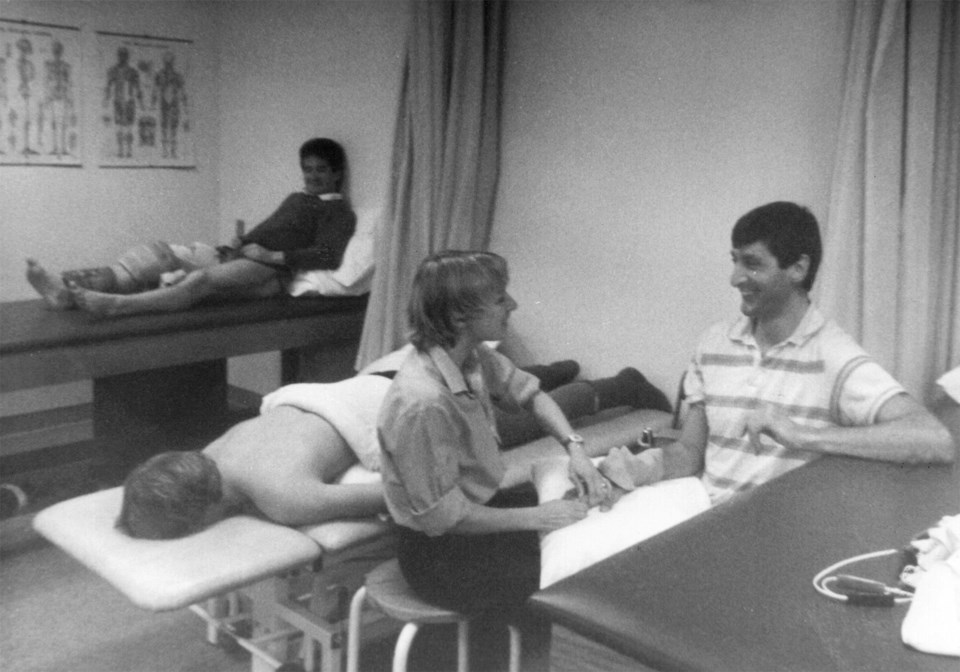When the Whistler Medical Centre moved into part of the basement of municipal hall in 1986, it was expected to be a temporary facility that would be replaced by a purpose-built facility in the coming years. Despite the temporary nature of the facility, the space tripled the size of the centre and was a huge improvement over its previous locations, which had been a double-wide trailer on Whistler Way and later the Whistler Golf Course parking lot.
The facility reportedly opened in 1986 with private offices for doctors (at the time there were still only two: Dr. Rob Burgess and Dr. Christine Rodgers; Whistler’s third doctor, Dr. Ron Stanley, joined the practice in 1988) and the public health nurse Marilyn McIvor, space for emergency patients, a casting bay, a lead-lined room for X-rays, and even a separate space for physiotherapy. By 1989, however, the growing medical needs of the community and visitors meant that the centre needed more room and a 16-metre trailer was installed near municipal hall to house physiotherapy and doctors’ offices.
But by 1993, the need for a new, permanent facility was acute. The municipal hall space was shared by a staff of 34 that included four nurses, an administrator, seven doctors, one lab technician, and six X-ray technicians, and could play host to more than 100 patients on busy days. Administrator Bev Wylie described the working conditions for staff as “comparable to a shoe box,” especially around holidays. According to Wylie, staff were doubled up in offices and the lunch room functioned as a meeting room, records room, supply room, coat closet, and quiet area. The incubator shared space in a hallway with stacks of files and a photocopier. The second-hand X-ray machine was already nine years old when it was installed in 1986 and designed to handle about 600 X-rays annually, but in Whistler it was doing more than 7,000 each year. Dr. Andrew Hamson told the Whistler Question that the centre could be “a complete, utter zoo.” Despite this, the staff continued to provide quality medical care to both residents and visitors.
In the January 14, 1993 edition of the Question, Janet Hamer, a nurse at the centre, compiled a list of cases the staff dealt with in 24 hours. From 8 a.m. to 8 a.m., staff treated burns, sore throats, colds, flus, frostbite, fractures, injuries from fights, allergies, neck injuries, head injuries, 11 knee injuries from skiing, an overdose of LSD, and multiple patients from car accidents. By 1:50 p.m., it was at least an hour to see a doctor, which became a two-hour wait at 1:55 p.m. when a helicopter arrived with a patient with serious head and chest injuries. The centre closed at 8 p.m., but the doctor on call returned at 8:25 p.m. to treat an anxiety attack and then had patients on and off until 6:45 a.m.
With funding from the Squamish-Lillooet Regional District hospital board and the provincial government, as well as lots of fundraising by the Whistler Health Care Society, other community groups, and individuals, the current Whistler Health Care Centre facility was ready to open in the summer of 1994. It reportedly had four times the space, with room for planned expansions (multiple expansions and upgrades to the centre have been completed since its opening in 1994; most recently, the Whistler Health Care Foundation raised money for a new trauma unit that was completed in February 2022). When asked what they thought of the new facility, Dr. Dan Wallman told the Question, “It’s a tremendous improvement for the community and us. I would like to thank everyone who donated their time, effort, and money to this cause.”
Lab technician Dawna Astle described it as “professional, air conditioned, clean, and about time too!”




